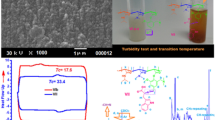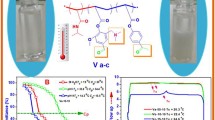Abstract
A new series of thermo-pH responsive polymers based on N-isopropylacrylamide and new cationic monomer has been synthesized from p-cresol in two facile steps and named by 2-((diethylamino)methyl)-4-methylphenyl acrylate), and abbreviated by (DEAMPA). It has been investigated by 1H NMR, 13C NMR, and FT IR. Three copolymers have been fabricated with three different molar concentrations of DEAMPA 5, 10, and 20 mol% using the free radical polymerization technique in solution. The copolymers have been chemically evaluated by 1H NMR and FT IR as well. Moreover, the physical characterizations were also investigated; the molecular weights and dispersity by GPC, the glass transition temperature by DSC, the change in the mass by decomposition using TGA, the degree of crystallinity by X-ray diffractions, and the morphological features by SEM. The change in the lower critical solution temperature and the phase separation of polymers solutions were measured by turbidity test as the change in transmittance with temperature with concerning the change in pH and using UV–VIS spectroscopy. The new cationic thermo-pH responsive copolymer will be used in the preparation of sensors, and dual responsive hydrogel.















Similar content being viewed by others
References
Liang H, Yu W, Qiang Z, Michael JS (2020) Stimuli-Responsive Actuation: Harnessing the Power of Stimuli-Responsive Polymers for Actuation. Adv Funct Mater 30:2070012. https://doi.org/10.1002/adfm.202070012
Elizabeth RG (2020) Reflections on the Evolution of Smart Polymers. Isr J Chem 60:75–85. https://doi.org/10.1002/ijch.201900075
Huanqing C, Qilong Z, Li Z, Xuemin D (2020) Intelligent Polymer-Based Bioinspired Actuators: From Monofunction to Multifunction. Adv Intell Syst 2000138:1–15. https://doi.org/10.1002/aisy.202000138
Abdelaty MSA (2018) Poly(N-isopropylacrylamide-co-2-((diethylamino)methyl)-4 formyl-6-methoxyphenylacrylate) Environmental Functional Copolymers: Synthesis, Characterizations, and Grafting with Amino Acids. Biomolecules 8:138. https://doi.org/10.3390/biom8040138
Abdelaty MSA (2018) Preparation and Characterization of Environmental Functional Poly(Styrene-Co-2-[(Diethylamino)Methyl]-4-Formyl-6-Methoxy-Phenyl Acrylate) Copolymers for Amino Acid Post Polymerization. Open Journal of Polymer Chemistry 8:41–55. https://doi.org/10.4236/ojpchem.2018.83005
Wang Y, Gong J, Hu W (2020) Transparency of Temperature-responsive Shape-memory Gels Tuned by a Competition between Crystallization and Glass Transition. Chin J Polym Sci. https://doi.org/10.1007/s10118-020-2456-0
Augustinus JJK, Nadia CMZ, Dirk JB, Albert PHJS (2019) Temperature-Responsive, Multicolor-Changing Photonic. Polymers ACS Appl Mater Interfaces 31:28172–28179. https://doi.org/10.1021/acsami.9b08827
Qiao S, Wang H (2018) Temperature-responsive polymers: Synthesis, properties, and biomedical applications. Nano Res 11:5400–5423. https://doi.org/10.1007/s12274-018-2121-x
Li Y, Xue Q, Zhang H et al (2020) Synthesis of optothermal responsive polymers by thiol-ene click reaction and their aggregation behavior. J Polym Res 27:172. https://doi.org/10.1007/s10965-020-02162-w
Banerjee P, Anas M, Jana S et al (2020) Recent developments in stimuli-responsive poly(ionic liquid)s. J Polym Res 27:177. https://doi.org/10.1007/s10965-020-02091-8
Ho DK, Nguyen DT, Thambi T et al (2019) Polyamide-based pH and temperature-responsive hydrogels: Synthesis and physicochemical characterization. J Polym Res 26:7. https://doi.org/10.1007/s10965-018-1666-4
Ulker D, Tuncer C, Sezgin SB et al (2017) An antibacterial composite system based on multi-responsive microgels hosting monodisperse gold nanoparticles. J Polym Res 24:169. https://doi.org/10.1007/s10965-017-1336-y
Mengle K, Xinwen P, Hao C, Peiwen L, Bo P, Kai Z (2020) pH-responsive polymeric nanoparticles with tunable sizes for targeted drug delivery. RSC Adv 10:4860–4868
Tao X, Ting L, Wei-Feng Z, Cheng-Sheng Z (2019) Ionic-Strength Responsive Zwitterionic Copolymer Hydrogels with Tunable Swelling and Adsorption Behaviors. Langmuir 35:1146–1155
Aleksey DD, Jesper deClaville C (2020) Mechanical response and equilibrium swelling of thermoresponsive copolymer hydrogels. Polym Int 69:974–984
ChuanShuang C, Pei H, Hui P, Meiwei Q, Qingsong X, Haojie D, Yi J, Yuling W, Chunyang Y, YongFeng Z (2021) A shish-kebab-like supramolecular polymer and its light-responsive self-assembly into nanofibers. Polym Chem Advance Article. https://doi.org/10.1039/D0PY01396J
Hongwei Z, Zhiwen W, Weifeng Z, Ximan T, Xilang J, Xingcai Z, You Y, Hanbin L, Yichao M, Shushu L, Weixing C (2021) Robust and sensitive pressure/strain sensors from solution processable composite hydrogels enhanced by hollow-structured conducting polymers. Chem Eng J 403:126307
Abdelaty MSA (2018) Environmental Functional Photo-Cross-Linked Hydrogel Bilayer Thin Films from Vanillin. J Polym Environ 26:2243–2256. https://doi.org/10.1007/s10924-017-1126-y
Abdelaty MSA (2019) Layer by Layer Photo-Cross-Linked Environmental Functional hydrogel Thin Films Based on Vanillin: Part 3. J Polym Environ 27:1212–1225. https://doi.org/10.1007/s10924-019-01421-2
Shengyi D, Jan H, Jiayin Y, Christoph AS (2016) Lower critical solution temperature (LCST) phase behaviour of an ionic liquid and its control by supramolecular host–guest interactions. Chem Commun 52:7970–7973
Fei W, Patrick A, Lorenz R, Haodong Z, Michael S, Britta N (2019) Progress Report on Phase Separation in Polymer Solutions. Adv Mater 31:1806733. https://doi.org/10.1002/adma.201806733
Jan S, Seema A (2013) Polymers with Upper Critical Solution Temperature in Aqueous Solution: Unexpected Properties from Known Building Blocks. ACS Macro Lett 7:597–600. https://doi.org/10.1021/mz400227y
Shibayama M, Tanaka T (1993) Volume phase transition and related phenomena of polymer gels. Adv Polym Sci 109:1–62. https://doi.org/10.1007/3-540-56791-7-1
Heskins M, Guillet J E (1968) Solution Properties of Poly(N-isopropylacrylamide). J Macromol Sci: Part A-Chem 2:1441–1455. https://doi.org/10.1080/10601326808051910
Kenji K, Shouei F, Isao A (1990) Solution Properties of Poly(N-isopropylacrylamide) in Water. Polym J 22:15–20
Scarpa JS, Mueller DD, Klotz IM (1967) slow hydrogen deuterium exchange in non-alpha helical polyamide. J Am Chem Soc 89:6024–6030
St K, Ilja V, Gerhard F-P, Gregor T (2009) pH and ionic strength responsive polyelectrolyte block copolymer micelles prepared by ring opening metathesis polymerization. J Polym Sci A Polym Chem 47:1178–1191. https://doi.org/10.1002/pola.23229
Naruphorn D, Farzad S, Juliette H, Daniel C (2020) Controlling release kinetics of pH-responsive polymer nanoparticles. Polym Chem 11:1752–1762. https://doi.org/10.1039/C9PY01946D
Nayeleh D, Changhe Z, Sarah S K, Angus P R J, Georgina K S (2019) pH-Responsive Polymer Nanoparticles for Drug Delivery. Macromol Rapid Commun 40:e1800917. https://doi.org/10.1002/marc.201800917
Lisa MF, Shengtong S, Volodymyr B, Matthias K, Cölfen H (2020) Tuning the properties of hydrogels made from poly(acrylic acid) and calcium salts. Phys Chem Chem Phys 22:18631–18638. https://doi.org/10.1039/D0CP02649B
Amzad MdH, Chanchal Kumar R, Stephen Don S, Hridoy R, Hasan Howlader A, Shakhawat HF (2020) Improvement of the strength of poly(acrylic acid) hydrogels by the incorporation of functionally modified nanocrystalline Cellulose. Mater Adv 1:2107–2116. https://doi.org/10.1039/D0MA00478B
Shannon MN, Steven PA (2020) Aqueous solution behavior of stimulus-responsive poly(methacrylic acid)-poly(2-hydroxypropyl methacrylate) diblock copolymer nanoparticles. Polym Chem 11:2147–2156. https://doi.org/10.1039/D0PY00061B
Timothy RB, Wilson CH, Christopher RT, Xiaoyu Z, Melanie AH, Paul AW, Robert MW (2020) Synthesis and mechanistic investigations of pH-responsive cationic poly(aminoester)s. Chem Sci 11:2951–2966. https://doi.org/10.1039/C9SC05267D
Wasiu A, Martin C, Peter CG (2020) Surfactant-Modulation of the Cationic-Polymer-Induced Aggregation of Anionic Particulate Dispersions. Polymers 12:287. https://doi.org/10.3390/polym12020287
Abdellaoui-Arous N, Djadoun S (2011) Poly[2-(N, N-Dimethylamino) Ethyl Methacrylate] /Poly(Styrene-Co-Methacrylic Acid) Interpolymer Complexes. Macromol Symp 303:123–133. https://doi.org/10.1002/masy.201150517
Lee S, Son SJ, Song SJ, Ha TH, Choi JS (2017) Polyamidoamine (PAMAM) Dendrimers Modified with Cathepsin-B Cleavable Oligopeptides for Enhanced Gene Delivery. Polymers 9:224
Zhengjian Z, Qilian Z, Yunzhi C, Zhihong L (2018) Poly(dimethyldiallylammonium chloride) (polyDADMAC) assisted cellulase pretreatment for microfibrillated cellulose (MFC) preparation and MFC analysis. Holzforschung 72:531–538. https://doi.org/10.1515/hf-2017-0152
Abdelaty, M SA (2020) The influence of vanillin acrylate derivative on the phase separation temperature of environmental photo-cross-linked n-isopropylacrylamide Copolymer and Hydrogel Thin Films. J Polym Environ 28:2599–2615. https://doi.org/10.1007/s10924-020-01793-w
Abdelaty MSA (2020) The Effect Hydrophilic/Hydrophobic Interaction of 2 ((Dimethylamino)methyl) 4 formyl 6 methoxyphenyl Acrylate and 4 Acetylphenyl Acrylate Monomers on the Phase Transition Temperature of N isopropylacrylamide Terpolymers. J Polym Environ 28:2584–2598. https://doi.org/10.1007/s10924-020-01790-z
Abdelaty MSA (2020) Influence of Vanillin Acrylate and 4-acetylphenyl acrylate hydrophobic functional monomers on Phase Separation of N-isopropylacrylamide Environmental Terpolymer: Fabrication and Characterization. Polym Bull 77:2905–2922. https://doi.org/10.1007/s00289-019-02890-0
Abdelaty MSA (2018) Environmental Functional Photo-cross-linked Hydrogel Bilayer Thin films From Vanillin (Part 2): Temperature responsive layer A, Functional, Temperature and pH layer B. Polym Bull 11:4837–4858. https://doi.org/10.1007/s00289-018-2297-y
Dirk S (2006) Thermo- and pH-responsive polymers in drug delivery. Adv Drug Deliv Rev 58:1655–1670
Yiwen P, Odilia RS, Jing Yang Q, Peter JR, Andrew BL (2015) pH-, thermo- and electrolyte-responsive polymer gels derived from a well-defined, RAFT-synthesized, poly(2-vinyl-4,4-dimethylazlactone) homopolymer via one-pot post-polymerization modification. Eur Polym J 62:204–213
Ramkissoon-Ganorkar C, Baudys M, Wan Kim S (2000) Effect of ionic strength on the loading efficiency” of the model polypeptide/protein drugs in pH-/temperature-sensitive polymers. J Biomat Sci Polym Ed 11:45–54 (PMID: 10680607)
Abdelaty MSA (2018) Preparation and Characterization of New Environmental Functional Polymers Based on Vanillin and N-isopropylacrylamide for Post Polymerization. J Polym Environ 26:636–646. https://doi.org/10.1007/s10924-017-0960-2
Abdelaty MSA, kuckling D, (2018) Poly (N-Isopropyl Acrylamide-Co-Vanillin Acrylate) Dual Responsive Functional Copolymers for Grafting Biomolecules by Schiff’s Base Click Reaction. Open Journal of Organic Polymer Materials 8:15–32. https://doi.org/10.4236/ojopm.2018.82002
Tan J, Xie S, Wang G, Yu CW, Zeng T, Cai P, Huang H (2020) Fabrication and Optimization of the Thermo-Sensitive Hydrogel Carboxymethyl Cellulose/Poly(N-isopropylacrylamide-co-acrylic acid) for U(VI) Removal from Aqueous Solution. Polymers 12:151. https://doi.org/10.3390/polym12010151
Fundueanu G, Constantin M, Bortolotti F, Cortesi R, Ascenzi P, Menegatti E (2007) Eur Polym J 43:3500–3509. https://doi.org/10.1016/j.eurpolymj.2007.05.026
Göktaş M (2020) Synthesis and characterization of temperature-responsive block copolymers using macromonomeric initiator. Chem Pap 74:2297–2307. https://doi.org/10.1007/s11696-020-01074-9
Doudou G, Lanlan D, Meng W, Xianxun W, Zhengguang S, Yuhong Z, Yulin L, Peixin H (2019) Preparation of thermo/redox/pH-stimulative poly(N-isopropylacrylamide-co-N, N′-dimethylaminoethyl methacrylate) nanogels and their DOX release behaviors. J Biomed Mater Res Part A 107A:1195–1203. https://doi.org/10.1002/jbm.a.36611
Orakdogen N (2014) Design and synthesis of dual-responsive hydrogels based on N, N-dimethylaminoethyl methacrylate by copolymerization with N-isopropylacrylamide. Macromol Res 22:32–41. https://doi.org/10.1007/s13233-014-2010-4
Wang B, Xu XD, Wang ZC, Cheng SX, Zhang XZ, Zhuo RX (2008) Synthesis and properties of pH and temperature sensitive P(NIPAAm-co-DMAEMA) hydrogels. Colloids Surf B Biointerfaces 64:34–41. https://doi.org/10.1016/j.colsurfb.2008.01.001
Abdelaty MSA, Kuckling D (2016) Synthesis and Characterization of New Functional Photo Cross-Linkable Smart Polymers Containing Vanillin Derivatives. Gels 2:1–13. https://doi.org/10.3390/gels2010003
Abdelaty MSA (2021) Trends in the phase separation temperature optimization of a functional and thermo-pH responsive terpolymer of poly (N-isopropylacrlamide-co-DMAEAm-co-VA). J Polym Environ. https://doi.org/10.1007/s10924-021-02096-4
Abdelaty MSA (2021) A facile Method for the Preparation of Hydrophilic-Hydrophobic Functional Thermo-pH Responsive Terpolymers Based on Poly(NIPAAm-co-DMAA-co-DMAMVA) and Post-Polymerization. J Polym Environ. https://doi.org/10.1007/s10924-021-02117-2
Fitzpatrick JR, Ellis B (1973) X-Ray Diffraction Studies of the Structure of Amorphous Polymers. In: Haward R.N. (eds) The Physics of Glassy Polymers. Materials Science Series. Springer, Dordrecht. https://doi.org/10.1007/978-94-010-2355-9_3
Acknowledgements
We would like to thank the University of Paderborn.
Author information
Authors and Affiliations
Corresponding author
Ethics declarations
Conflicts of Interest
The authors declare that there are no conflicts of interest regarding the publication of this paper.
Additional information
Publisher's Note
Springer Nature remains neutral with regard to jurisdictional claims in published maps and institutional affiliations.
Rights and permissions
About this article
Cite this article
Abdelaty, M.S.A. Poly(N-isopropylacrylamide-co-2-((diethylamino)methyl)-4-methylphenyl acrylate) thermo-ph responsive copolymer: trend in the lower critical solution temperature optimization of Poly (N-isopropyylacrylamide). J Polym Res 28, 213 (2021). https://doi.org/10.1007/s10965-021-02574-2
Received:
Accepted:
Published:
DOI: https://doi.org/10.1007/s10965-021-02574-2




